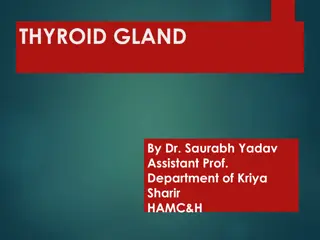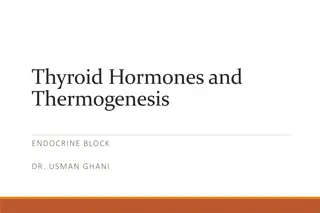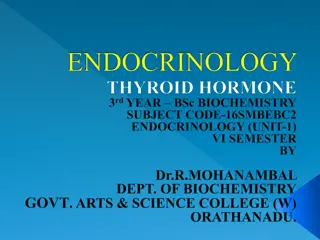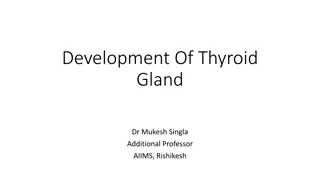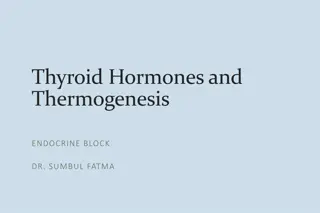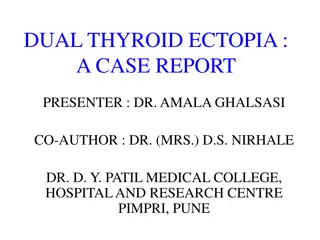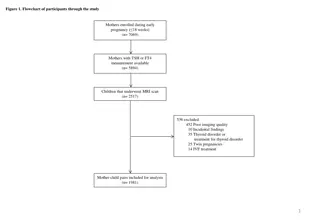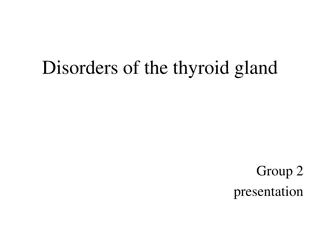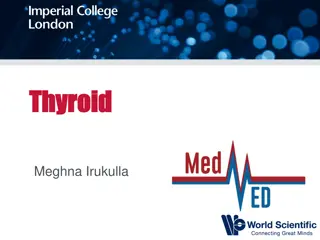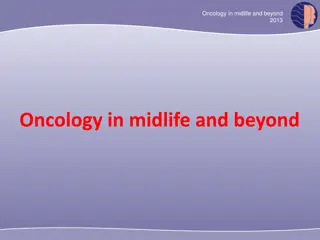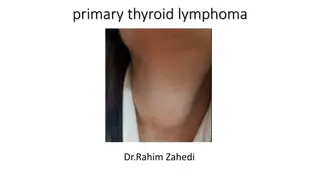
Increasing Incidence of Thyroid Cancer in Differentiated Thyroid Cancer
Explore the rising incidence of thyroid cancer, particularly in women below 45 years old, and the challenges in interpreting trends due to factors like subclinical reservoirs. Discuss the impact of detection and true increase hypotheses on disease rates.
Download Presentation

Please find below an Image/Link to download the presentation.
The content on the website is provided AS IS for your information and personal use only. It may not be sold, licensed, or shared on other websites without obtaining consent from the author. If you encounter any issues during the download, it is possible that the publisher has removed the file from their server.
You are allowed to download the files provided on this website for personal or commercial use, subject to the condition that they are used lawfully. All files are the property of their respective owners.
The content on the website is provided AS IS for your information and personal use only. It may not be sold, licensed, or shared on other websites without obtaining consent from the author.
E N D
Presentation Transcript
AACE/ACE Disease State Clinical Review AMERICAN ASSOCIATION OF CLINICAL ENDOCRINOLOGISTS AND AMERICAN COLLEGE OF ENDOCRINOLOGY DISEASE STATE CLINICAL REVIEW: The INCREASING INCIDENCE OF THYROID CANCER ENDOCRINE PRACTICE VoL 21.6 JUNE 2015 by: Dr Narimani
INTRODUCTION Thyroid cancer is the most common endocrine cancer. Based on recent data, thyroid cancer is the fifth most common cancer in women , and in Italy, it is the second most frequent cancer in women below 45 years of age. Only in few countries (Norvay, Sweden) thyroid cancer incidence is decreased
Thyroid cancer has been much in the news lately because of reports of large increases in incidence. It is now recognized that not all pathologic entities labeled as cancer act similarly, nor do they all act aggressively. It is increasingly recognized that measures of incidence, mortality, and survival may be affected by many epidemiologic factors and may not always be reflective of either true increases in disease, treatment successes, or screening efforts
A current example is found in prostate cancer, a disease for which 20 years ago screening and aggressive treatment were recommended. Screening now is no longer uniformly advised, after it was understood that the disease is present at autopsy in many asymptomatic men dying of other causes. Although thyroid cancer is different from prostate cancer in that it is not detected through concerted screening programs, it does have a similar large subclinical reservoir and is often found at autopsy in asymptomatic people who died of other causes.
This has made it challenging to interpret observed trends in the incidence and mortality of thyroid cancer in the U.S. Outline the current incidence and mortality trends for differentiated thyroid cancer and examine the 2 main hypotheses about the cause of the increasing incidence: (1) The detection of a subclinical reservoir (2) A true increase in the disease due to known or new risk factors.
METHODS Epidemiologic Data Data on the incidence of thyroid cancer are from SEER 9 (Surveillance, Epidemiology and End Results) Program, supported by the National Cancer Institute, from 1975 to 2011. SEER 9 covers approximately 10% of the U.S. population and includes the longest contributing sites to the program: Atlanta, Connecticut, Detroit, Hawaii, Iowa, New Mexico, San Francisco-Oakland, Seattle-Puget Sound, and Utah.
SEER is the best source of population based data available in the U.S. For cancer incidence, histology, and initial treatment because it is gathered from high-quality registries chosen specifically to accurately represent the U.S. population and because it is extensively quality checked. Mortality data are from the Centers for Disease Control National Vital Statistics System.
For all incidence calculations, we included all incident cases of cancer with thyroid as the site of origin (The International Classification of Diseases for histology,Third Revision [ICD-03]. Rates were calculated for each year using SEERStat v.8.1.5 (Surveillance Research Program of the National Cancer Institute, Rockville, MD). All rates were age adjusted to the 2000 standard population.
Histology was categorized as follows: papillary follicular, and poorly differentiated a combination of medullary and anaplastic. Histologic classification was accepted as reported by each registry, slides were not re-read by a central monitoring body.
Review of Contributors to Thyroid Cancer s Increasing Incidence An initial broad search of the literature was performed to identify commonly hypothesized reasons for the increasing incidence of thyroid cancer. Next, a detailed literature search of PubMed for English- language studies published prior to December 31, 2013 was performed for the topic areas deemed likely to represent potential causes of the increasing incidence. Two topic areas were not subjected to detailed search based on limited supporting evidence: bisphenol A and progesterone. Studies were selected for inclusion if they were clinical trials, large cohort studies, or considered likely to be influential to research or clinical practice.
RESULTS Part I: Current Epidemiology of Thyroid Cancer in the U.S. In 2014, it was estimated that there would be 62,980 new cases of thyroid cancer in the U.S. Thyroid cancer accounts for about 3.8% of new cancers diagnosed each year in the U.S. and is the ninth most common in incidence after prostate, breast, lung, colon, melanoma of the skin, bladder, non-Hodgkin s lymphoma, and renal cancer. Deaths due to thyroid cancer are uncommon. It was estimated that there would be an estimated 1,890 deaths due to thyroid cancer in the U.S. in 2014. The more common cancers, such as breast and lung, lead to deaths in the hundreds of thousands each year.
Overall Incidence Trends Thyroid cancer incidence was relatively stable until the 1990s, when it began to increase dramatically (Fig. 1). Overall thyroid cancer incidence increased from 4.9 per 100,000 population to 14.7 per 100,000 population in 2011. The rise has been due almost entirely to papillary histology (rising from 3.4 to 13.1 per 100,000), with a tiny contribution from follicular histology (rising from a range of 0.75 to 1.0 per 100,000 in 1975-1977 to 0.97 to 1.15 per 100,000 in 2009-2011).
Trends in Incidence by Size Examining incidence rates by size gives clues about potential causes of the increase. Thyroid cancers of all sizes increased between 1983 and 2011, the greatest contribution in both relative and absolute terms came from small cancers (Fig. 2). The incidence of the smallest cancers (2 cm or less) increased more than 4-fold, from 2 to 9.6 per 100,000 population. Cancers measuring 2.1 to 5 cm more than doubled in incidence, from 1.4 to 3.7 per 100,000 population. Cancers measuring greater than 5 cm are quite rare, but their rates tripled, from 0.2 to 0.7 per 100,000 population.
Trends in Incidence by Age Group The incidence of thyroid cancer is highest among those over age 65 years. Since 1975, the incidence has risen dramatically in all age groups (Fig. 3). The largest burden of the increase in absolute terms has been in those aged 65 years and over; the incidence increased from 8 to 23.4 per 100,000 population in 2011. The greatest relative increase has been in those aged 20 to 64 years. The incidence rate went from 6.4 to 19.5 per 100,000 population in 2011, a 3.1-fold increase. Among those aged 0 to 19 years, there has been a similar relative change of 2.6-fold, but thyroid cancer in this group is very rare and has risen in absolute terms from only 0.4 to 1 per 100,000 population in 2011.
Current Trends in Mortality Mortality from thyroid cancer hovers around 0.5 per 100,000 population. Between 1975 and 2010 (the most recent year for which data are available), the high was recorded in 1977, at 0.57 per 100,000 population (approximately 1,710 deaths per year nationwide), and the low was recorded in 1994, at 0.42 per 100,000 population (approximately 1,260 deaths per year nationwide). Between 2001 and 2010, the mortality rate varied between 0.45 and 0.52 per 100,000 population, never moving outside the range we have seen over the past 30 years.
Because the mortality rate for thyroid cancer is so low, any fluctuations appear relatively large. Thus, statistical tests of trend reported by SEER do show a 0.9% increase in this time period, but examination of the underlying data suggest that the trend is not indicative of clinically or epidemiologically relevant changes overall, because the data have not varied outside the range we have observed over the past 30 years.
Trends in Molecular Profiles Studies of archival thyroid cancer specimens show historical shifts in the landscape of molecular alterations (e.g., rearrangements in the BRAF, RAS, and RET/PTC genes). In a recent study analyzing trends in demographic, clinical, pathologic, and molecular characteristics of papillary thyroid cancer from 1974 to 2009, one group found 3 important trends in the mutational composition of papillary thyroid cancer over time:
(1) the overall proportion of RAS point mutations increased significantly after 2000, due entirely to increases in the follicular variant of papillary thyroid cancer; (2) the proportion of BRAF mutations was stable over the time period; (3) the proportion of RET/PTC rearrangements significantly decreased.
They concluded that rising percentages of the follicular variant histology and RAS mutations after 2000 suggest (a) new etiologic factors and (b) The increased incidence is not likely due to radiation because RET/PTC rearrangements decreased.
In another recent study, the rate of the BRAF V600E mutation was seen to rise over 15 years of archived thyroid specimens. The authors concluded that BRAF mutations in papillary thyroid cancer may be contributing to the increasing incidence of thyroid cancer. Collectively, these data are intriguing, but because they are potentially confounded by secular trends in the detection of subclinical cancers, more work will be required to determine whether molecular changes are a significant contributor to the increasing incidence of thyroid cancer.
In a survey conducted by the Iranian Cancer Institute, 1.8% of all cancers and 76.1% of all endocrine cancers constituted by the neoplasm of thyroid gland; In a study in Iran, mean age of Iranian patients was 42.8 years (95% CI: 41.9-43.7) with markedly older male patients.Also, the female to male ratio was about 1.8
based on the national registry data from 2003 to 2009 thyroid cancer represents 2.1% of all new cancer cases in the world, 3.0% in WHO Americas region, 2.4% in Iran, 2.2% in less developed regions, 2.1% in Asia, 2% in more developed regions, and 1.7% in WHO Europe Region. The incidence of thyroid cancer increased from 2003 to 2009 in Iranian population. The age standardized rate for women and men increased from 2.02 and 0.82 to 4.2 and 1.36 per 100,000, respectively.
Part II: Examination of Hypotheses for the Increasing Incidence Hypothesis #1: The Increased Incidence of Thyroid Cancer is Due to Detection of Subclinical Disease
Evidence for and Against the Hypothesis There is strong evidence to support the hypothesis that the increasing incidence of thyroid cancer is due to the detection of subclinical disease, termed overdiagnosis in cancer epidemiology. First, papillary thyroid cancer is commonly found at autopsy in people who died of other causes. Estimates of the prevalence range from about 3 to about 35%, depending on the country of the study and the pathology methods used to examine the specimens.
Among thyroid specimens removed for benign disease, up to 50% harbor small, incidental papillary thyroid cancers Another observation that supports the subclinical disease detection hypothesis is the fact that the majority of the increase has been observed in small cancers. The largest rate increases have been observed in cancers that are too small even for most experienced clinicians to feel during thyroid palpation.
Small cancers are less likely to be causing symptoms at the time of their discovery and are in the size range commonly found in the autopsy studies described above. Last, mortality rates have not changed substantially over the 30 years that thyroid cancer incidence has been rising. Some argue that this is because of improving treatments. For this to be the case, the changes in treatment would have had to exactly keep pace with the increasing incidence;
if improvements in treatment occurred too fast, the mortality line would fall. If improvements in treatment occurred too slowly, the mortality line would rise. Although this is possible, it is not particularly plausible. This finding of stable mortality means that in a setting of increasing numbers of thyroid cancers being detected, only a small constant number are aggressive, lethal cancers.
Proposed Mechanisms of Detection of Subclinical Thyroid Cancer There are several interrelated mechanisms through which subclinical thyroid cancers might be detected. These are outlined in Table 1 and detailed below. Access to health care services has been shown to be a determinant of thyroid cancer incidence rates by making it more likely that a subclinical cancer is found.
A current example is South Korea. Between 1996 and 2010, the age-adjusted incidence of thyroid cancer in women residing in the Gwangju and Jeonnam provinces in South Korea increased from 10.6 to 111.3 per 100,000 population, and in men, the incidence increased from 1.9 to 27.0 per 100,000 population.
Despite these increases, thyroid cancer mortality remained stable. The incidence change was mainly attributable to the detection of asymptomatic cancers (which increased from less than 5% to more than 50% of all cancers) and sub-centimeter cancers (the rate increased from 0 to 50 per 100,000 population). The primary mechanism of detection has been physician- offered thyroid ultrasound screenings. A 2009 survey showed 13% of South Korean adults had undergone a screening thyroid ultrasound. The rate was higher among women, with the highest rate (26%) among women 50 to 59 years old .
Health care financing systems also affect thyroid cancer incidence rates. A 2012 study modeled thyroid cancer incidence based on the characteristics of national health systems. Adjusted for gross domestic product and education levels, the share of health care expenditure that was privately funded was a significant predictor of thyroid cancer incidence (for women, P = .02; men, P = .09). Health care systems with more fee for service, private models had higher incidence rates of thyroid cancer .
General increases in imaging rates have made thyroid findings more common. In a recent study of a large health care system , people underwent an average of 1.18 imaging studies per year, of which 35% were advanced diagnostic imaging studies: computed tomography (CT), magnetic resonance imaging (MRI), nuclear medicine, or ultrasound. Over the 15 years of the study, imaging rates for CT scanning increased 8% annually. MRI rates increased 10% annually, ultrasound 4%, and positron emission tomography scanning 57% (2004 to 2010 only). It is likely that increased rates of imaging have led to more thyroid findings.
Physician management of identified thyroid nodules has also changed. Guidelines were not common in the 1970s. One article from this era suggested that thyroid nodules smaller than 2 cm do not require intervention . Guidelines from 2009 and 2010 suggest that in some circumstances, nodules of any size might be appropriate to biopsy . Similarly, recommendations for thyroid surgery for small papillary cancers have also shifted. Until recently, at least one guideline still listed thyroid lobectomy as an appropriate treatment , but more recently, total thyroidectomy has been the standard recommendation for thyroid cancers of any size.
More frequent biopsies and larger specimens provide more opportunities for pathologists to find cancer; thus, it is likely that these 2 phenomena are contributing to the increasing incidence of thyroid cancer. Thyroidectomy volumes have increased as a result of changes in imaging rates and physician behavior. A study using the population-based Nationwide Inpatient Sample and National Survey of Ambulatory Surgery databases estimated that annual thyroid surgery volumes increased 39% over 10 years, from 66,864 in 1996 to 92,931 in 2006 . More thyroidectomies means more specimens to examine for cancer, another contributing factor to increased detection.
Pathologist management of thyroid specimens has also changed. Surgical pathology textbooks from the 1980s suggested 5 descriptive areas for a surgical pathology report of a thyroid specimen . The 2012 guidelines from the College of American Pathologists list a minimum of 14 descriptive areas; each thyroid specimen is examined much more closely compared to the past . Furthermore, whereas historically only representative sections of a thyroid specimen were examined by a pathologist, the thyroid specimen in its entirety is now typically examined, increasing the chances for identification of small cancers.
Lastly, although there has been no official change in the definition of follicular or papillary thyroid cancer by the World Health Organization, pathologists now categorize more cases as follicular variant of papillary carcinoma rather than follicula adenoma. Together with the increased numbers of thyroid specimens delivered to pathologists, these changes are likely a significant contributor to the increasing identification of thyroid cancer.
Hypothesis #2: The Increased Incidence of Thyroid Cancer is Due to a True Rise in Disease
Evidence for and Against the Hypothesis A major argument against detection of subclinical disease as a cause of the increasing incidence of thyroid cancer is that the entire increase in thyroid cancer incidence has not been due to the detection of small cancers. Larger cancers and those diagnosed at a more advanced stage (i.e., with lymph node metastases) have also increased in incidence.
however, that even large cancers may be picked up incidentally, making it possible that the increasing incidence of large cancers is not due to a true rise in disease. A recent paper reported that 38% of cancers larger than 4 cm had been found incidentally on imaging studies done for other reasons. Some also suspect that mortality trends might not have changed yet due to long patient survival times with papillary thyroid cancer.
Some have suggested that the rise in papillary thyroid cancer alone suggests that increased detection is not occurring, because one would also expect increases across all specified histologies except anaplastic. However, the SEER data available do not show a reciprocal decrease in the incidence of follicular thyroid carcinoma during the past decades, the most likely substitution for a diagnosis of papillary cancer
Proposed Mechanisms Causing a True Increase in the Incidence of Thyroid Cancer



